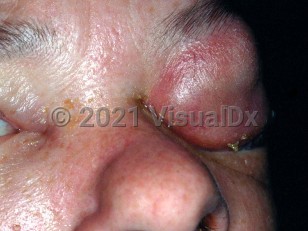Orbital cellulitis in Child
See also in: Cellulitis DDx,External and Internal EyeSynopsis

It presents clinically as eyelid erythema and edema with signs of orbital involvement. There may be associated fever, headache, nasal discharge, malaise, blurry or double vision, proptosis, or chemosis of the conjunctiva. The most common causative organisms are Staphylococcus and Streptococcus species, although fungi such as Mucor and Aspergillus may cause orbital cellulitis. The rate of this disease attributable to Haemophilus influenzae type b has dropped considerably since introduction of the Hib vaccine.
The complications of orbital cellulitis include permanent vision loss, orbital and subperiosteal abscesses, cavernous sinus thrombosis, meningitis, and cerebral abscesses, which can lead to death if not treated in a timely fashion.
Orbital cellulitis is a medical emergency and therefore must be distinguished from the milder preseptal cellulitis and other causes of eyelid erythema and edema. Signs of orbital involvement, such as proptosis and ophthalmoplegia (limited eye movement), are almost always present.
Codes
H05.019 – Cellulitis of unspecified orbit
SNOMEDCT:
194005002 – Orbital Cellulitis
Look For
Subscription Required
Diagnostic Pearls
Subscription Required
Differential Diagnosis & Pitfalls

Subscription Required
Best Tests
Subscription Required
Management Pearls
Subscription Required
Therapy
Subscription Required
References
Subscription Required
Last Updated:07/29/2019


